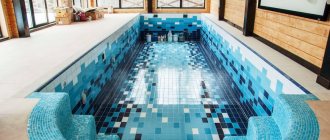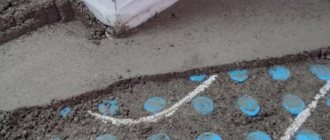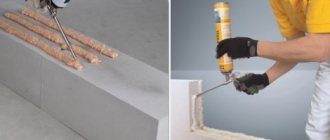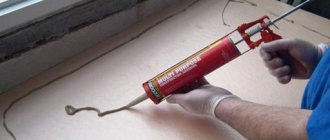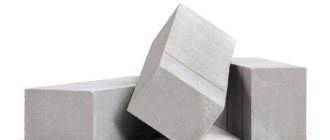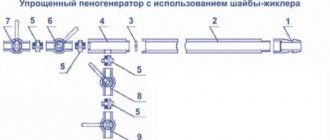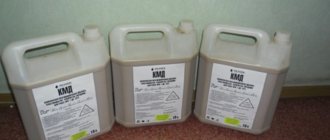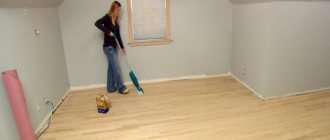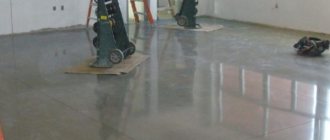Foam cement MACROFLEX
Aerosol polyurethane foam cement MACROFLEX in the delivered condition is completely ready for use for its intended purpose - repair, sealing, connection and fastening of various construction and installation materials.
Main technical and consumer characteristics:
- One hundred percent substitute for Portland cement and similar dry mixtures;
- Easy to use packaging in an aerosol can;
- Excellent adhesion to the substrates being connected – a durable seam. In particular, the mechanical tensile strength of a foam-cement joint is: 20 kgf/cm2 for wood (corresponds to the adhesion strength of concrete-granite), 10 kgf/cm2 for PVC (corresponds to the adhesion strength of concrete-cement mortar), 3 kgf/cm2 for concrete, OSB boards, glass and ceramics, 2.5 kgf/cm2 for bitumen coating and foam plastic (corresponds to the strength of adhesive for ceramic tiles);
- Suitable for attaching wall panels and other objects to vertical surfaces;
- Allows both external and internal use;
- Excellent sealing, heat and sound insulation abilities;
- Allowed for use in the ambient temperature range from -5...35 °C (optimal application temperature 21...25 °C);
- Time for the formation of a solid substance: 25-30 minutes.
Mounting foam, sealant, liquid nails, pva, wallpaper glue
FOME FLEX AQUARIUM aquarium sealant
FOME FLEX AQUARIUM aquarium sealant
Acidic silicone sealant with excellent mechanical properties and fast curing speed for sealing aquariums and for use in various industrial applications.
When hardened, it is absolutely safe for aquatic organisms. Thixotropic, does not spread in the seam. Adheres well to many non-porous silicate materials, such as glass, brick, ceramics, enamel, glazed stone and clinker tiles; with impregnated, varnished or painted wood; with numerous plastics such as epoxy, polyester, polyacrylate and laminate. Hardens quickly: quickly becomes covered with a film. Perfectly processed. Areas of application:
The product is suitable for filling connecting gaps between floors and 8 roofs.
Suitable for filling cracks and holes with low movement, for repairing small leaks and open holes in flat roofs, and for filling gaps between sheet metal (aluminium, lead, copper and tin) and bitumen sheets. Conditions of use:
Application temperature from +5 “C to +30” C.
Surfaces in contact with the sealant must be clean and free of particles. Instructions for use:
Application temperature from +5 “C to +40” C.
During operation, the temperature of the sealant should be +20 °C - +25 °C. Seams can be filled at temperatures below +5 °C only when the sealed surfaces are not in contact with condensation, ice and snow. The sealant must be completely cured before filling the aquarium with water. Once dry, silicone is not toxic to living organisms. Suitable for sealing aquariums in accordance with DIN 32622, maximum aquarium dimensions 200x60x60 cm, using glass of suitable thickness and type. Technical data:
| Property | Unit | Meaning |
| Surface drying | minutes | 10-12 |
| Curing speed | mm/24 h | 3-4 |
| Density DIN 53 479- B | g/cm3 | 1.02 |
| Properties of cured sealant | ||
| Extrusion speed, hole 3 mm.0.63 N/mm2 | ml/min | 250 |
| Tensile Strength (ISO 8339) | N/mm2 | 1.8 |
| Tensile to Break (ISO 8339) | % | 200 |
| Modulus of elasticity at 100% elongation (ISO 8339) | N/mm2 | 0.55 |
| Hardness (Shore A) (ISO 868) | 20±2 | |
| Mobility (ISO 11600) | % | ±25 |
| Temperature stability | WITH | -40 to +80 |
| Tear resistance | N/mm | 5,7 |
The given parameters were obtained at a temperature of +23 °C and a relative air humidity of 50%.
Scope of application
Despite its unique consumer qualities, MACROFLEX foam cement is not economically feasible to use as the main binding material in the construction of buildings and structures. At the same time, MACROFLEX is a worthy replacement for cement in the following types of construction and installation work:
- Construction of light interior lintels and local restoration of block or brickwork;
- Installation of heat-insulating mats to facades, inner surfaces of walls and foundations;
- Repair work;
- Installation of window frames, stair steps and installation of window sills;
- Sealing gaps and waterproofing construction joints.
At the same time, according to experts, the average consumption of the MACROFLEX foam-cement material is one cylinder with a capacity of 850 ml per 10 m2 of brickwork “in one brick” or for the installation of gypsum panels with an area of 12 m2.
Advantages and disadvantages
- Convenience and ease of use, all other things being equal;
- The ability to provide accurate dosage, eliminating overconsumption and non-production residues;
- Reliable heat and moisture insulation of seams.
The disadvantages include the relatively high cost of MACROFLEX foam cement (from 287 to 420 rubles per 850 ml package), the need to purchase a gun for applying polyurethane foam costing from 567 to 1680 rubles and purchasing a special Premium Cleaner costing from 124 to 265 rubles per 500 ml bottle.
According to the method of release from the cylinder
There are household foams with an adapter tube and professional ones, they are also called pistol foams. If everything is clear with ordinary polyurethane foam, everyone has used it at least once, but not everyone has had the opportunity to work with professional foam.
Many people know that household foams are equipped with a plastic pipe through which the composition is supplied to the surface. If this tube is not cleaned after use, it will be virtually impossible to use any remaining foam. That is, in fact, household foam cylinders are disposable.
In contrast, professional foams are reusable and are applied using a gun. The quality of the latter affects the performance of work. When using a “bad” gun, the pressure it creates is not enough - and it is not possible to completely empty the cylinder, and productivity drops. In addition, the connection between the cylinder and the low-quality gun is not sealed enough, the gas passes through the valve, which also does not make it possible to completely use up the composition.
The gun should be cleaned immediately after removing the empty container from it, without allowing the foam to harden inside the gun, since in this case it will be impossible to clean the gun with a solvent. It is recommended to clean the gun with a universal cleaner of uncured polyurethane foam or another product designed for this purpose. Other solvents may damage the gun. Never use water to clean the gun!
We also approached the issue of cleaning foam from surfaces. Regardless of whether you use spray foam or a can with an adapter, you are not protected from foam splashing and getting on your hands, face, or clothes. Is it possible to remove frozen foam from the surface? How to remove it?
Theoretically, any polyurethane foam containing acetone is dissolved by it. In practice, it is not recommended to use it for every surface due to the risk of damage to these surfaces. Then a foam cleaner will help. Manufacturers produce polyurethane foam cleaners in two versions - for removing fresh, just sprayed polyurethane foam and for removing hardened foam. The cleaners contain thixotropic solvents that soften the remaining foam and easily remove it from the contaminated area without damaging the surface.
So that you don’t have to wonder how to clean polyurethane foam at home, it makes sense to purchase a cleaner immediately when purchasing polyurethane foam.
Leave the emotion
Like Touched Ha-Ha Wow Sad I'm angry
Tags: Mixtures 2373
Support the Homeowner Encyclopedia project, subscribe to our channel in Yandex.Zen
Features of application
- Laying bricks and blocks using MACROFLEX. Foam cement is applied to the connecting surfaces of each brick or block in the form of two continuous strips, spaced 50 mm from the edge. When laying half a brick, one central strip is allowed. Laying bricks or blocks on the foundation is carried out only after preliminary leveling of the surface (with cement mortar);
- Installation of drywall. Allows you to avoid installing expensive and labor-intensive sheathing. In this case, MACROFLEX foam is applied over the entire area of the plasterboard sheet in even strips with a step of 150 and a distance of 50 mm from the edge. Next, the sheet is applied to the base, pressed down and kept in this state for 5 minutes;
- Installation of window sills, frames and stair steps. 2-3 strips of MACROFLEX are applied to the surface of the product in contact with the base, after which the product is implemented to the base and loaded along the entire perimeter to be glued for 60 minutes.
Pros and cons of foam
The main advantage of any mounting mixture packaged in a tube is its ease of use. Macroflex foam is easily applied using a gun, which allows you to control the amount of composition squeezed out, avoiding overuse. Cementing adhesive at the point of application reliably insulates the seams from moisture and significantly reduces heat loss.
The disadvantages of any polyurethane foam usually include high shrinkage. But foam cement initially has a small expansion volume, so it “shrinks” less noticeably. But another disadvantage follows from the high density - high consumption of the composition.
The cost of cement adhesive does not differ from the price of conventional polyurethane foam - 370-390 rubles per 850 ml.
Features of application
Construction adhesive foam of the Macroflex brand allows in some cases to abandon heavy cement mortars when performing repair and construction operations:
- Construction of light lintels and restoration of block masonry.
- Insulation and finishing of surfaces with slab materials.
- Installation of window sills, frames, stair elements.
- Eliminating gaps, strengthening and insulating seams.
The glue consumption depends on the building material you have to work with. According to reviews, it takes one standard 850 ml cylinder to complete 10 m2 of brick-thick masonry. The same amount will be required for gluing gypsum panels with a total area of up to 12 m2.
Application of the building mixture is allowed on any wet materials except foam concrete.
Application for different types of work
- Brick or block masonry.
The composition is applied to the bonded surfaces of each block in two continuous strips with a distance of 30-50 mm from the edge. If the masonry is half a brick wide, you can get by with one strip of Macroflex cement in the center. Brickwork using foam is carried out only on a leveled surface, so that there are no vertical distortions in the rows. If this is not the case, you need to lay regular mortar of large thickness on the foundation and set the correct level of the first row.
Professional foam Macroflex, although it belongs to building compositions, is not suitable for laying critical load-bearing walls. Its main purpose is the installation of internal partitions and installation of small architectural structures.
- Drywall.
It is faster and easier to glue drywall onto a relatively flat surface than to assemble a complex sheathing underneath. The glue is applied to the back of the gypsum board over the entire area in strips - a pitch of 150 mm, a distance from the edge of 50 mm. Everything needs to be done at a pace, because after 3 minutes, if you do not put the sheet in place, the surface of the foam cement will stop sticking.
Once Macroflex is applied, the sheet is applied to the prepared wall surface and lightly pressed down. You need to hold the panel for 5 minutes, after which you can move on to the next one. Grouting and other finishing work can be done 2 hours after gluing.
- Installation of window sills, steps.
Squeeze 2-3 strips of Macroflex along the edge onto the fixing part of the window sill. Press it against the end surface of the wall, loading it along its entire length for an hour. Make sure that the window sill is clearly level. The same principle is used to install individual steps of prefabricated flights of stairs from any materials.
Useful tips and tricks
Before using MACROFLEX foam cement, the surfaces to be bonded should be thoroughly cleaned of any contaminants and degreased in one way or another. Before direct use, if possible, foam containers are kept at a temperature of 20-23 degrees Celsius for 12 hours and shaken vigorously with sharp movements at least 20 times.
The gun can be removed from the cylinder only after the cylinder is completely empty, after which its applicator is immediately washed with Premium Cleaner. Or, if the installation and construction work is not completed, it is replaced as quickly as possible with a fresh container of MACROFLEX foam cement
According to application temperature
There are winter, summer and universal mounting foams. Let's start with universal polyurethane foam, also called all-season foam.
This foam can be used in a wide temperature range from -10 to +25 °C. It is the most common and is used most often. However, it is necessary to understand that such all-season use is rather arbitrary; the optimal temperature range for use and storage of this type of foam is from +5 to +25 °C. Now the most interesting part: what is the difference between summer foam and winter foam? In winter, at low temperatures and low air humidity, the course of chemical reactions slows down, the viscosity of the material increases, and the pressure in the cells (structure) of the foam decreases.
It should also be remembered that during the curing of the foam, intensive absorption of moisture from the air occurs, and in winter the humidity is reduced.
Winter foams, unlike summer ones, have a different formula - they are modified with special additives that allow you to work with foam in winter at low ambient temperatures and low air humidity.
Operating temperatures of winter foam range from -18 to +25 °C. It should be noted that the volume of foam after its spraying and expansion decreases in proportion to the decrease in ambient temperature. For example, the foam output from a 300 ml container at a temperature of +20 °C is 30 liters, at 0 °C - about 25 liters, at -5 °C - about 20 liters, at -10 °C - about 15 liters.
The operating temperature of summer mounting foams is the highest compared to winter and all-season foam: from +5 to +25 °C. This allows you to work even on the hottest days without fear of changing the foam characteristics.
